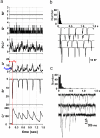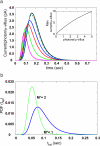Systems analysis of the single photon response in invertebrate photoreceptors
- PMID: 18653755
- PMCID: PMC2492478
- DOI: 10.1073/pnas.0711884105
Systems analysis of the single photon response in invertebrate photoreceptors
Abstract
Photoreceptors of Drosophila compound eye employ a G protein-mediated signaling pathway that transduces single photons into transient electrical responses called "quantum bumps" (QB). Although most of the molecular components of this pathway are already known, the system-level understanding of the mechanism of QB generation has remained elusive. Here, we present a quantitative model explaining how QBs emerge from stochastic nonlinear dynamics of the signaling cascade. The model shows that the cascade acts as an "integrate and fire" device and explains how photoreceptors achieve reliable responses to light although keeping low background in the dark. The model predicts the nontrivial behavior of mutants that enhance or suppress signaling and explains the dependence on external calcium, which controls feedback regulation. The results provide insight into physiological questions such as single-photon response efficiency and the adaptation of response to high incident-light level. The system-level analysis enabled by modeling phototransduction provides a foundation for understanding G protein signaling pathways less amenable to quantitative approaches.
Conflict of interest statement
The authors declare no conflict of interest.
Figures






Similar articles
-
A stochastic model of the single photon response in Drosophila photoreceptors.Integr Biol (Camb). 2010 Aug;2(7-8):354-70. doi: 10.1039/c0ib00031k. Epub 2010 Jul 21. Integr Biol (Camb). 2010. PMID: 20648395
-
Speed of phototransduction in the microvillus regulates the accuracy and bandwidth of the rhabdomeric photoreceptor.PLoS Comput Biol. 2020 Nov 16;16(11):e1008427. doi: 10.1371/journal.pcbi.1008427. eCollection 2020 Nov. PLoS Comput Biol. 2020. PMID: 33196643 Free PMC article.
-
A biomimetic fly photoreceptor model elucidates how stochastic adaptive quantal sampling provides a large dynamic range.J Physiol. 2017 Aug 15;595(16):5439-5456. doi: 10.1113/JP273614. Epub 2017 May 17. J Physiol. 2017. PMID: 28369994 Free PMC article. Review.
-
Single photon responses in Drosophila photoreceptors and their regulation by Ca2+.J Physiol. 2000 Apr 1;524 Pt 1(Pt 1):179-94. doi: 10.1111/j.1469-7793.2000.00179.x. J Physiol. 2000. PMID: 10747191 Free PMC article.
-
Phototransduction in Drosophila.Sci China Life Sci. 2012 Jan;55(1):27-34. doi: 10.1007/s11427-012-4272-4. Epub 2012 Feb 8. Sci China Life Sci. 2012. PMID: 22314488 Review.
Cited by
-
Phototransduction motifs and variations.Cell. 2009 Oct 16;139(2):246-64. doi: 10.1016/j.cell.2009.09.029. Cell. 2009. PMID: 19837030 Free PMC article. Review.
-
Common mechanisms regulating dark noise and quantum bump amplification in Drosophila photoreceptors.J Neurophysiol. 2013 Apr;109(8):2044-55. doi: 10.1152/jn.00001.2013. Epub 2013 Jan 30. J Neurophysiol. 2013. PMID: 23365183 Free PMC article.
-
Fractional Ca(2+) currents through TRP and TRPL channels in Drosophila photoreceptors.Biophys J. 2013 May 7;104(9):1905-16. doi: 10.1016/j.bpj.2013.03.047. Biophys J. 2013. PMID: 23663833 Free PMC article.
-
Stochastic, adaptive sampling of information by microvilli in fly photoreceptors.Curr Biol. 2012 Aug 7;22(15):1371-80. doi: 10.1016/j.cub.2012.05.047. Epub 2012 Jun 14. Curr Biol. 2012. PMID: 22704990 Free PMC article.
-
Random Photon Absorption Model Elucidates How Early Gain Control in Fly Photoreceptors Arises from Quantal Sampling.Front Comput Neurosci. 2016 Jun 24;10:61. doi: 10.3389/fncom.2016.00061. eCollection 2016. Front Comput Neurosci. 2016. PMID: 27445779 Free PMC article.
References
-
- Hardie RC, Raghu P. Visual transduction in Drosophila. Nature. 2001;413:186–193. - PubMed
-
- Hardie RC, et al. Molecular basis of amplification in Drosophila phototransduction: Roles for G protein, phospholipase C, and diacylglycerol kinase. Neuron. 2002;36:689–701. - PubMed
-
- Hardie RC. TRP channels in Drosophila photoreceptors: the lipid connection. Cell Calcium. 2003;33:385–393. - PubMed
-
- Ranganathan R, Malicki DM, Zuker CS. Signal transduction in Drosophila photoreceptors. Annu Rev Neurosci. 1995;18:283–317. - PubMed
Publication types
MeSH terms
Substances
Grants and funding
LinkOut - more resources
Full Text Sources
Molecular Biology Databases

